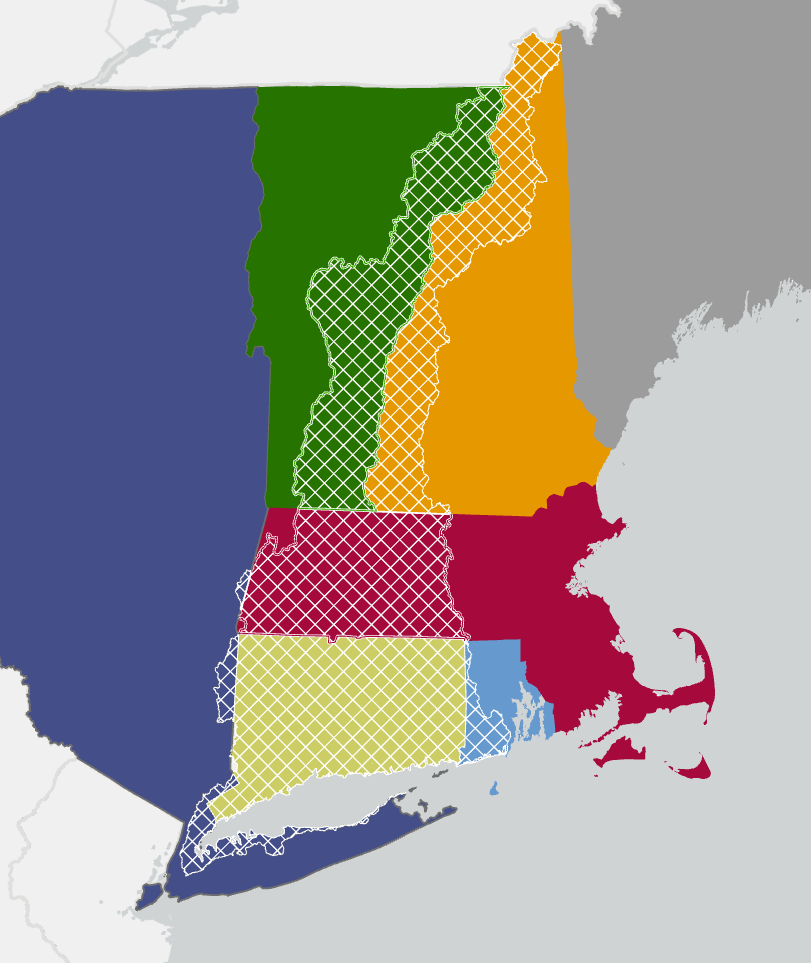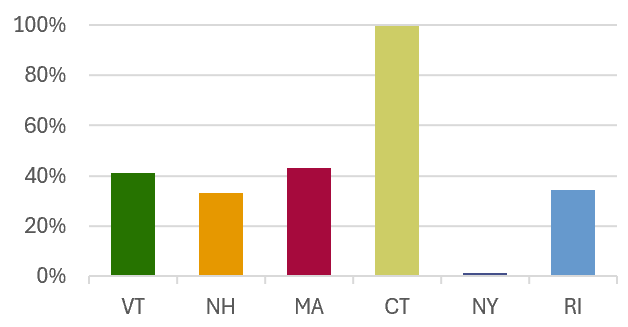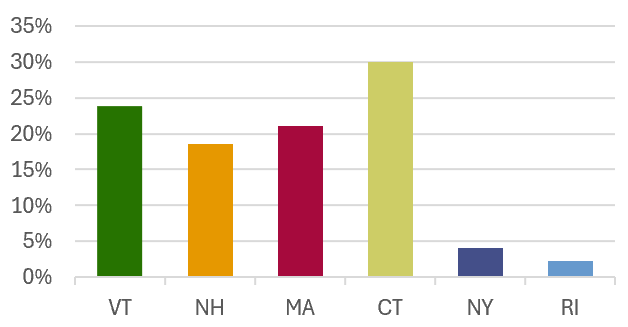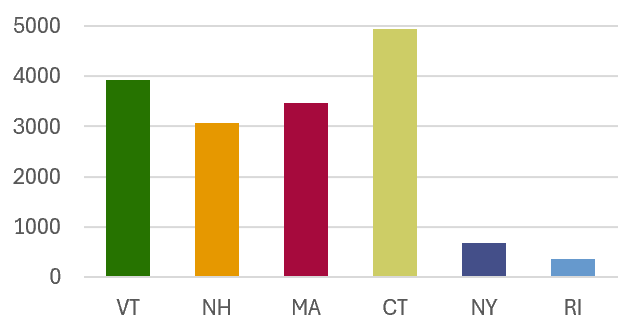This project funded by the Long Island Sound Partnership.
Changing Landscape is a project of UConn CLEAR that utilizes land cover maps derived from satellite images to map and quantify land cover change over time. The work presented here uses the National Land Cover Database (NLCD) land cover as input to the analyses and maps that are shared.
About the National Land Cover Database (NLCD)
The U.S. Geological Survey’s (USGS) Land Cover program has leveraged methodologies from legacy land cover projects together with modern innovations in geospatial methods to create the next generation of land cover and land change information. The result is Annual NLCD from 1985 to present.
The Annual NLCD land cover provides a categorical sixteen-class land cover classification system. The land cover product represents the predominant surface state within the mapping year with respect to broad categories of artificial or natural surface
cover.
Map Viewer and Data Dashboards
U.S. Geological Survey (USGS), 2024, Annual NLCD Collection 1 Science Products: U.S. Geological Survey data release, https://doi.org/10.5066/P94UXNTS
Why use NLCD?
Understanding changes in land cover is essential to understanding environmental impacts due to land conversion, natural resource conservation and management, land use planning, and much more. In order to see and analyze land cover and land cover change in Connecticut and the lower Long Island Sound Watershed, UConn CLEAR started the Changing Landscape study. It grew over time and ended with 30 years of land cover (7 dates between 1985 and 2015). The land cover dates were created so that they could be compared for changed. The data and analyses have been invaluable to many users and disciplines.
Due to changes in personnel and technology, UConn CLEAR stopped creating its Changing Landscape land cover with the 2015 dataset. As time passed, the gap grew along with the need for updated land cover with the ability to assess change.
Although the National Land Cover Database (NLCD) has been around for decades, they recently released the Annual NLCD Land Cover which contains annual land cover datasets that can be compared over time. That means Land Cover Change! Game changer! Additionally, the NLCD Land Cover is updated on a predictable schedule by the United State Geologic Survey (USGS). UConn CLEAR has transitioned to using Annual NLCD Land Cover for Changing Landscape Studies. It is called Changing Landscape with NLCD.
National Land Cover Database (NLCD) Classes
Land Cover Classes
Land Cover Classes used in the Map Viewer and Data Dashboard
Aggregated Class |
NLCD Class(es) |
Description |
|
|---|---|---|---|
| Water | Open Water | Water | |
| Developed | High Intensity Developed, Medium Intensity Developed, Low Intensity Developed | Developed areas with high amounts of impervious surface or impervious surface mixed with other land cover types. Typically found in cities and residential areas. Note that the Developed Class is not the same as the Impervious layer. See FAQs for more information. | |
| Developed Open Space | Developed Open Space | Areas with a mixture of some constructed materials, but mostly vegetation in the form of lawn grasses. These areas most commonly include large-lot single-family housing units, parks, golf courses, and vegetation planted in developed settings for recreation, erosion control, or aesthetic purposes. | |
| Forest | Deciduous Forest, Evergreen Forest, Mixed Forest, Shrub/Scrub, Woody Wetlands | Areas dominated by trees. This class includes shrub/scrub which are shorter trees or shrubs. | |
| Agriculture | Pasture/Hay, Cultivated Crops | Fields of grass or other plants for livestock grazing or production of crops. | |
| Barren | Barren (Rock/Sand/Clay) | Areas of bedrock, desert pavement, scarps, talus, slides, volcanic material, glacial debris, sand dunes, strip mines, gravel pits and other accumulations of earthen material. Generally, vegetation accounts for less than 15% of total cover. | |
| Wetland | Emergent Herbaceous Wetlands | Vegetated areas where the soil or substrate is periodically saturated with or covered with water. | |
| Grass | Grassland/Herbaceous | Areas dominated by grasses and similar low vegetation and not subject to agricultural activities. |
Full NLCD Class Descriptions
| Class Number |
Class |
Description |
|
|---|---|---|---|
| 11 | Open Water | areas of open water, generally with less than 25% cover of vegetation or soil. | |
| 24 | Developed, High Intensity | highly developed areas where people reside or work in high numbers. Examples include apartment complexes, row houses and commercial/industrial. Impervious surfaces account for 80% to 100% of the total cover. | |
| 23 | Developed, Medium Intensity | areas with a mixture of constructed materials and vegetation. Impervious surfaces account for 50% to 79% of the total cover. These areas most commonly include single-family housing units. | |
| 22 | Developed, Low Intensity | areas with a mixture of constructed materials and vegetation. Impervious surfaces account for 20% to 49% percent of total cover. These areas most commonly include single family housing units. | |
| 21 | Developed, Open Space | areas with a mixture of some constructed materials, but mostly vegetation in the form of lawn grasses. Impervious surfaces account for less than 20% of total cover. These areas most commonly include large-lot single-family housing units, parks, golf courses, and vegetation planted in developed settings for recreation, erosion control, or aesthetic purposes. | |
| 41 | Deciduous Forest | areas dominated by trees generally greater than 5 meters tall, and greater than 20% of total vegetation cover. More than 75% of the tree species shed foliage simultaneously in response to seasonal change. | |
| 42 | Evergreen Forest | areas dominated by trees generally greater than 5 meters tall, and greater than 20% of total vegetation cover. More than 75% of the tree species maintain their leaves all year. Canopy is never without green foliage. | |
| 43 | Mixed Forest | areas dominated by trees generally greater than 5 meters tall, and greater than 20% of total vegetation cover. Neither deciduous nor evergreen species are greater than 75% of total tree cover. | |
| 52 | Shrub/Scrub | areas dominated by shrubs; less than 5 meters tall with shrub canopy typically greater than 20% of total vegetation. This class includes true shrubs, young trees in an early successional stage or trees stunted from environmental conditions. | |
| 71 | Grassland/Herbaceous | areas dominated by graminoid or herbaceous vegetation, generally greater than 80% of total vegetation. These areas are not subject to intensive management such as tilling but can be utilized for grazing. | |
| 81 | Pasture/Hay | areas of grasses, legumes, or grass-legume mixtures planted for livestock grazing or the production of seed or hay crops, typically on a perennial cycle. Pasture/hay vegetation accounts for greater than 20% of total vegetation. | |
| 82 | Cultivated Crops | areas used to produce annual crops, such as corn, soybeans, vegetables, tobacco, and cotton, and perennial woody crops such as orchards and vineyards. Crop vegetation accounts for greater than 20% of total vegetation. This class also includes all land being actively tilled. | |
| 90 | Woody Wetlands | areas where forest or shrubland vegetation accounts for greater than 20% of vegetative cover and the soil or substrate is periodically saturated with or covered with water. | |
| 95 | Emergent Herbaceous Wetlands | areas where perennial herbaceous vegetation accounts for greater than 80% of vegetative cover and the soil or substrate is periodically saturated with or covered with water. | |
| 31 | Barren (Rock/Sand/Clay) | areas of bedrock, desert pavement, scarps, talus, slides, volcanic material, glacial debris, sand dunes, strip mines, gravel pits and other accumulations of earthen material. Generally, vegetation accounts for less than 15% of total cover. |
Full descriptions on the MRLC (Multi-Resolution Land Characteristics Consortium) National Land Cover Database Class Legend and Description page. Note that some class colors have been modified and that some NLCD classes do not occur in the study area including Perennial Ice/Snow, Dwarf Scrub, Lichens, and Moss.
Change To Classes
Change To Classes
| Developed before 1985 | |
| Developed Open Space before 1985 | |
| Water | |
| Undeveloped | |
| Change to Developed between 1985 and 2023 | |
| Change to Developed Open Space between 1985 and 2023 | |
| Other |
Developed is a combination of the NLCD classes of low, medium, and high density developed.
See Land Cover Classes tab for full class descriptions.
Change From Classes
Change From Classes
| Developed before 1985 | |
| Developed Open Space before 1985 | |
| Water | |
| Undeveloped | |
| Agriculture to Developed between 1985 and 2023 | |
| Agriculture to Developed Open Space between 1985 and 2023 | |
| Forest to Developed* between 1985 and 2023 | |
| Forest to Developed Open Space between 1985 and 2023 | |
| Other Classes to Developed between 1985 and 2023 | |
| Other Classes to Developed Open Space between 1985 and 2023 | |
| Other |
Developed is a combination of the NLCD classes of low, medium, and high density developed.
Agriculture is a combination of the Crop and Hay/Pasture classes
Forest is a combination of Deciduous Forest, Coniferous Forest, Mixed Forest, Shrub, and Forested Wetland.
See Land Cover Classes tab for full class descriptions.
Frequently Asked Questions (FAQs)
What happened to “Turf” and what is “Developed Open Space”?
Coming Soon!
What is the “Riparian Area” and why does it matter?
The Riparian Area is the land that is a specified distant from waterbodies (lakes, large rivers) and water courses (streams and rivers). Riparian Area, Riparian Zone, and Riparian Buffer are different terms that all refer to generally the same area - land in proximity to water.
The riparian area is particularly important for water quality. A vegetated riparian zone results in cleaner water as vegetation filters and cleans water that runs off from the land before it reaches the stream, river, or lake. Other land cover types, such as developed and impervious surfaces, don't filter water while also contributing pollutants.
Riparian Area of a Basin
ADD GRAPHICS
How do I Download Data or Connect to Services?
Download and map services are intended for GIS users.
Services
There are several places to find the services that are part of the Land Cover Map Viewer and Data Dashboards.
CT ECO Services page - Look for the Land Cover category and any services that include Changing Landscape with NLCD.
CT ECO ArcGIS Online Organization- Go to the Gallery and Look for services that pertain to Changing Landscape with NLCD. Many of these items are also available on the CT Geodata Portal.
NLCD services via MRLC - The NLCD services are also available directly from the MRLC website in WMS format. The page includes instructions as connecting to these services. Note that this is not a CT ECO service and any problems or questions should be directed to USGS.
Download
Download land cover data from USGS and the Multi-Resolution Land Characteristics Consortium (MRLC). Land cover data is designed to be viewed and analyzed withing GIS (Geographic Information System) software or similar. To view the land cover for the country, visit the MRLC Map Viewer.
More Information about NLCD Land Cover
Annual National Land Cover Database (NLCD) Collection 1 Products (ver.1.1, June 2025) Report | pdf
Annual NLCD Information from the Multi-Resolution Land Characteristics Consortium (MRLC)
Summaries (Basin)
The Long Island Sound Watershed is the drainage area for Long Island Sound, which means that any water or rain in the watershed may eventually flow into Long Island Sound. Long Island Sound is the body of water between the Connecticut shoreline and the north shore of Long Island in New York. The Long Island Sound Watershed starts in Canada and includes potions of Vermont, New Hampshire, Massachusetts, Connecticut, New York, and Rhode Island. It is 16,455 square miles.
| Area in watershed* (sq miles) |
Percent of state in watershed* |
Percent of watershed* covered by the state |
|
| VT | 3933.1 | 41.1% | 23.9% |
| NH | 3060.1 | 33.0% | 18.6% |
| MA | 3470.0 | 42.9% | 21.1% |
| CT | 4943.7 | 99.5% | 30.0% |
| NY | 675.8 | 1.4% | 4.1% |
| RI | 371.8 | 34.5% | 2.3% |
*Watershed refers to the Long Island Sound Watershed

Long Island Sound Watershed (white hatch) over states.

Percent of state in the Long Island Sound Watershed

Percent of Long Island Sound Watershed
in State

State Area (sq. miles) in the
Long Island Sound Watershed
See the Data Dashboards for a complete and interactive look at land cover statistics.
Land Cover Stats: Long Island Sound Watershed Summary
UPDATE DATA - THIS IS CT
Area is in square miles. See above for class descriptions.
Class |
1985 |
1990 |
1995 |
2000 |
2005 |
2010 |
2015 |
2020 |
2023 |
Change
|
|
|---|---|---|---|---|---|---|---|---|---|---|---|
| Developed |
3124.8 | 3115.4 | 3100.6 | 3077.9 | 3048.6 | 3033.1 | 3021.4 | 3005.4 | 2998.1 | 133.0 | |
| 63.2% | 63.0% | 62.7% | 62.3% | 61.7% | 61.4% | 61.1% | 60.8% | 60.6% | 2.7% | ||
| Developed Open Space |
532.0 | 552.0 | 563.9 | 587.0 | 619.3 | 638.2 | 647.7 | 658.5 | 665.0 | 46.2 | |
| 10.8% | 11.2% | 11.4% | 11.9% | 12.5% | 12.9% | 13.1% | 13.3% | 13.5% | 0.9% | ||
| Grasses |
733.0 | 734.8 | 747.1 | 752.5 | 754.6 | 760.7 | 767.7 | 775.0 | 779.2 | 6.7 | |
| 14.8% | 14.9% | 15.1% | 15.2% | 15.3% | 15.4% | 15.5% | 15.7% | 15.8% | 0.1% | ||
| Agriculture |
368.3 | 355.8 | 347.4 | 340.4 | 334.0 | 324.6 | 318.8 | 313.2 | 309.5 | -58.8 | |
| 7.5% | 7.2% | 7.0% | 6.9% | 6.8% | 6.6% | 6.5% | 6.3% | 6.3% | -1.2% | ||
| Forest |
35.0 | 34.5 | 34.7 | 34.0 | 34.3 | 35.4 | 35.7 | 35.6 | 36.1 | -126.7 | |
| 0.7% | 0.7% | 0.7% | 0.7% | 0.7% | 0.7% | 0.7% | 0.7% | 0.7% | -2.6% | ||
| Water |
118.1 | 120.1 | 119.0 | 120.2 | 119.4 | 116.8 | 115.6 | 115.4 | 114.3 | -3.8 | |
| 2.4% | 2.4% | 2.4% | 2.4% | 2.4% | 2.4% | 2.3% | 2.3% | 2.3% | -0.1% | ||
| Wetland |
16.3 | 14.8 | 14.5 | 15.0 | 15.8 | 16.8 | 18.6 | 22.5 | 23.1 | 1.1 | |
| 0.3% | 0.3% | 0.3% | 0.3% | 0.3% | 0.3% | 0.4% | 0.5% | 0.5% | 0.0% | ||
| Barren |
16.2 | 16.4 | 16.5 | 16.8 | 17.8 | 18.0 | 18.2 | 18.2 | 18.4 | 2.2 | |
| 0.3% | 0.3% | 0.3% | 0.3% | 0.4% | 0.4% | 0.4% | 0.4% | 0.4% | 0.0% |
Area is in square miles.
See above for class descriptions.
Class |
1985 |
1990 |
1995 |
2000 |
2005 |
2010 |
2015 |
2020 |
2023 |
Change
|
|
|---|---|---|---|---|---|---|---|---|---|---|---|
| Impervious |
300.1 | 311.7 | 319.3 | 331.1 | 346.8 | 356.7 | 361.5 | 367.0 | 370.1 | 69.9 | |
| 6.1% | 6.3% | 6.5% | 6.7% | 7.0% | 7.2% | 7.3% | 7.4% | 7.5% | 1.4% |
Land Cover Stats: CT within the Long Island Sound Watershed
See the Data Dashboards on the XX for a complete and interactive look at land cover statistics.
Connecticut is 99.5% within the Long Island Sound Watershed.
Area is in square miles. See above for class descriptions.
Class |
1985 |
1990 |
1995 |
2000 |
2005 |
2010 |
2015 |
2020 |
2023 |
Change
|
|
|---|---|---|---|---|---|---|---|---|---|---|---|
| Developed |
3124.8 | 3115.4 | 3100.6 | 3077.9 | 3048.6 | 3033.1 | 3021.4 | 3005.4 | 2998.1 | 133.0 | |
| 63.2% | 63.0% | 62.7% | 62.3% | 61.7% | 61.4% | 61.1% | 60.8% | 60.6% | 2.7% | ||
| Developed Open Space |
532.0 | 552.0 | 563.9 | 587.0 | 619.3 | 638.2 | 647.7 | 658.5 | 665.0 | 46.2 | |
| 10.8% | 11.2% | 11.4% | 11.9% | 12.5% | 12.9% | 13.1% | 13.3% | 13.5% | 0.9% | ||
| Grasses |
733.0 | 734.8 | 747.1 | 752.5 | 754.6 | 760.7 | 767.7 | 775.0 | 779.2 | 6.7 | |
| 14.8% | 14.9% | 15.1% | 15.2% | 15.3% | 15.4% | 15.5% | 15.7% | 15.8% | 0.1% | ||
| Agriculture |
368.3 | 355.8 | 347.4 | 340.4 | 334.0 | 324.6 | 318.8 | 313.2 | 309.5 | -58.8 | |
| 7.5% | 7.2% | 7.0% | 6.9% | 6.8% | 6.6% | 6.5% | 6.3% | 6.3% | -1.2% | ||
| Forest |
35.0 | 34.5 | 34.7 | 34.0 | 34.3 | 35.4 | 35.7 | 35.6 | 36.1 | -126.7 | |
| 0.7% | 0.7% | 0.7% | 0.7% | 0.7% | 0.7% | 0.7% | 0.7% | 0.7% | -2.6% | ||
| Water |
118.1 | 120.1 | 119.0 | 120.2 | 119.4 | 116.8 | 115.6 | 115.4 | 114.3 | -3.8 | |
| 2.4% | 2.4% | 2.4% | 2.4% | 2.4% | 2.4% | 2.3% | 2.3% | 2.3% | -0.1% | ||
| Wetland |
16.3 | 14.8 | 14.5 | 15.0 | 15.8 | 16.8 | 18.6 | 22.5 | 23.1 | 1.1 | |
| 0.3% | 0.3% | 0.3% | 0.3% | 0.3% | 0.3% | 0.4% | 0.5% | 0.5% | 0.0% | ||
| Barren |
16.2 | 16.4 | 16.5 | 16.8 | 17.8 | 18.0 | 18.2 | 18.2 | 18.4 | 2.2 | |
| 0.3% | 0.3% | 0.3% | 0.3% | 0.4% | 0.4% | 0.4% | 0.4% | 0.4% | 0.0% |
Area is in square miles.
See above for class descriptions.
Class |
1985 |
1990 |
1995 |
2000 |
2005 |
2010 |
2015 |
2020 |
2023 |
Change
|
|
|---|---|---|---|---|---|---|---|---|---|---|---|
| Impervious |
300.1 | 311.7 | 319.3 | 331.1 | 346.8 | 356.7 | 361.5 | 367.0 | 370.1 | 69.9 | |
| 6.1% | 6.3% | 6.5% | 6.7% | 7.0% | 7.2% | 7.3% | 7.4% | 7.5% | 1.4% |
Land Cover Stats: MA within the Long Island Sound Watershed
See the Data Dashboards on the XX for a complete and interactive look at land cover statistics.
Massachusetts is 43% within the Long Island Sound Watershed. 3470 square miles of Massachusetts are part of the Long Island Sound Watershed. ADD GRAPHIC
UPDATE DATA - THIS IS CT
Area is in square miles. See above for class descriptions.
Class |
1985 |
1990 |
1995 |
2000 |
2005 |
2010 |
2015 |
2020 |
2023 |
Change
|
|
|---|---|---|---|---|---|---|---|---|---|---|---|
| Developed |
3124.8 | 3115.4 | 3100.6 | 3077.9 | 3048.6 | 3033.1 | 3021.4 | 3005.4 | 2998.1 | 133.0 | |
| 63.2% | 63.0% | 62.7% | 62.3% | 61.7% | 61.4% | 61.1% | 60.8% | 60.6% | 2.7% | ||
| Developed Open Space |
532.0 | 552.0 | 563.9 | 587.0 | 619.3 | 638.2 | 647.7 | 658.5 | 665.0 | 46.2 | |
| 10.8% | 11.2% | 11.4% | 11.9% | 12.5% | 12.9% | 13.1% | 13.3% | 13.5% | 0.9% | ||
| Grasses |
733.0 | 734.8 | 747.1 | 752.5 | 754.6 | 760.7 | 767.7 | 775.0 | 779.2 | 6.7 | |
| 14.8% | 14.9% | 15.1% | 15.2% | 15.3% | 15.4% | 15.5% | 15.7% | 15.8% | 0.1% | ||
| Agriculture |
368.3 | 355.8 | 347.4 | 340.4 | 334.0 | 324.6 | 318.8 | 313.2 | 309.5 | -58.8 | |
| 7.5% | 7.2% | 7.0% | 6.9% | 6.8% | 6.6% | 6.5% | 6.3% | 6.3% | -1.2% | ||
| Forest |
35.0 | 34.5 | 34.7 | 34.0 | 34.3 | 35.4 | 35.7 | 35.6 | 36.1 | -126.7 | |
| 0.7% | 0.7% | 0.7% | 0.7% | 0.7% | 0.7% | 0.7% | 0.7% | 0.7% | -2.6% | ||
| Water |
118.1 | 120.1 | 119.0 | 120.2 | 119.4 | 116.8 | 115.6 | 115.4 | 114.3 | -3.8 | |
| 2.4% | 2.4% | 2.4% | 2.4% | 2.4% | 2.4% | 2.3% | 2.3% | 2.3% | -0.1% | ||
| Wetland |
16.3 | 14.8 | 14.5 | 15.0 | 15.8 | 16.8 | 18.6 | 22.5 | 23.1 | 1.1 | |
| 0.3% | 0.3% | 0.3% | 0.3% | 0.3% | 0.3% | 0.4% | 0.5% | 0.5% | 0.0% | ||
| Barren |
16.2 | 16.4 | 16.5 | 16.8 | 17.8 | 18.0 | 18.2 | 18.2 | 18.4 | 2.2 | |
| 0.3% | 0.3% | 0.3% | 0.3% | 0.4% | 0.4% | 0.4% | 0.4% | 0.4% | 0.0% |
Area is in square miles.
See above for class descriptions.
Class |
1985 |
1990 |
1995 |
2000 |
2005 |
2010 |
2015 |
2020 |
2023 |
Change
|
|
|---|---|---|---|---|---|---|---|---|---|---|---|
| Impervious |
300.1 | 311.7 | 319.3 | 331.1 | 346.8 | 356.7 | 361.5 | 367.0 | 370.1 | 69.9 | |
| 6.1% | 6.3% | 6.5% | 6.7% | 7.0% | 7.2% | 7.3% | 7.4% | 7.5% | 1.4% |
